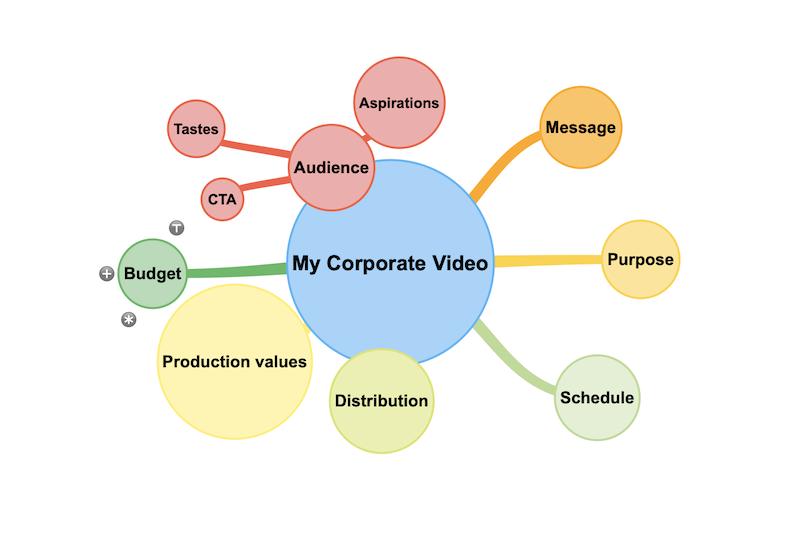This may be stating the obvious, but planning a corporate video carefully is likely to improve your chances of success! Well-designed video content targets the right audience and motivates them to act in your favour. Ill-considered content is far less likely to do either of these. Read on to learn about the process involved in planning your corporate video production.
Where do I begin planning my corportate video?
If you’re reading this article, chances are that you’re thinking seriously about producing a corporate video for your organisation. However, while you might have a sense of need and perhaps some ideas, you’re not sure how to move forward.
Video, like any other form of media production, can seem daunting and even a little mysterious. However, just like many things in life, you’ll find that there are well-established paths to success.
Planning your corporate video is like planning a party.
Bear with me a little. I promise this isn’t as ridiculous as it sounds.
The starting point for your party is its purpose. Are you marking a birthday, celebrating Christmas, or showing friends your new home, etc? Likewise, your corporate video should start life with a specific purpose in mind. You may be announcing a new product, recruiting, or training, for example.
When you throw a party, you need to plan certain essentials: who you’re going to invite, what food and drinks will you serve, what music will you play? In addition, you’ll also need to find a venue, and you might want to add decorations to this for a little sparkle.
Now think of your party guests as your video’s audience. Think of the menu, drinks, and music as your video’s content. Finally, think of your party venue as the logistics of your production, and the decorations as the overall style of your production.

Planning a corporate video production has a lot in common with planning a party.
1. What’s the purpose of your video?
You need to be clear about what you’re trying to achieve from the word go. Many corporate video productions fail because their purpose isn’t clarified in the planning stages. Commonly these failures happen when people try to cram too much into one production, losing focus as a result. Key messages begin to compete with each other, and the audience is left confused. To continue the party metaphor: No one would combine birthday parties for an 18-year-old and their 9-year-old sibling.
The very first thing you need to do is to clarify your core purpose. Apart from anything else, this is key to knowing if video is actually the right tool for the job. As a general rule, a corporate video should have a single purpose. This will produce one clear message that inspires an equally clear response from the audience.
2. Identify your target audience?
We’ve already established that lacking a clear sense of purpose will damage your chances of success. The same goes for not identifying and understanding your target audience. We’re now at the stage in our party planning where we’re drawing up the guest list.
Different groups can have very different needs, tastes, and motivations. Knowing exactly who your video production is aimed at is crucial to formulating your key messages. Much of your video’s general style or production value also depends upon this knowledge.

Understanding your target audience is crucial to success.
Learn more about audience targeting.
3. How will you engage your target audience?
Having established who your target audience is, you can now begin to consider what they want. Returning to our party scenario, this is like establishing how many vegetarians, teetotallers, or food allergy sufferers will be coming. Not doing this could lead to an epic fail in terms of engaging some of your guests. Likewise, failing to understand your video’s audience will probably mean you fail to engage them, so you’d best find out what makes them tick.
How do you go about doing this?
Simple really, you ask!
If you’re unclear as to the motivations of your target audience, you will need to do a little market research. This could include talking to them directly using primary research methods like surveys or focus groups. Likewise, you could also conduct some secondary research by looking at existing data sources relating to your target audience. In addition, you could look at how others have addressed a similar audience. Arming yourself with as much information as possible is the key to success.
4. Shape your key message.
Everything we’ve looked at so far is about informing our video production. We’re now at the stage where, armed with clear aims and audience knowledge, we can start sketching things out.
Shaping your video’s key message to strike a chord with your target audience is crucial. This is why you need to test all of your ideas against what you know about them. You need to start talking in their language and thinking from the perspective of their experience and zeitgeist.
Absolutely critical is knowing how you want your audience to respond to your video. What do you want them to think? How do you want them to feel? What do you want them to do?
Related: Marketing videos and the power of narrative.
Planning the style of your corporate video.
Part of shaping your key message for your target audience is considering the overall style of your video. Will your delivery be serious and hard-hitting, light-hearted and humorous, or maybe deep and thought-provoking? Again, making sure you remain consistent is important. This will affect everything from the script to final editing.
5. Draw up a strategy for your video.
- How will you create your video, in-house or with professional support from a production partner?
- What distribution channels will you use to get your video to your target audience, e.g., social media, website, etc?
- How will you evaluate your video’s effectiveness?
- How might your video be used in the future?
- What do you expect the shelf life of your video to be and when will you need to replace it?

Having a video strategy helps you to exploit your finished production.
6. Draw up a production brief.
A production brief is a relatively simple idea, but it can prove useful as an aide-mémoire throughout production. Think of it as your party shopping list. It should contain:
- The main aim of your project.
- Your target audience and insights about them.
- The message you want to send.
- The shape and style of delivery.
- Your desired audience response.
- The practical parameters of your project like budget, location, and time frame.
If you’re working with a video production partner, they can help you to draw up your production brief. Their experience will help you to identify any gaps or points that need to be clarified before production begins.
Once completed, your production brief should be the reference point around which all decisions are made. That way, your project will stay on track.
Learn more about writing a clear production brief.
Time to get serious.
At this point, you’re ready to move forward with pre-production for your video. Therefore, if you haven’t done so already, you’ll probably want to discuss your project with a number of potential production companies. Armed with a clear production brief, you’re in a position to do this from an informed position, rather than simply having a vague notion of what you want from the project.
Learn more about working with a video production company.
Stourbridge-based Mooma Media offers event audio-visual support, event filming, live-streaming, video production, and still photography services to businesses, the public sector, and other non-commercial organisations throughout the Black Country and the wider West Midlands region. To discuss your project, or for a competitive quote click the button below.
Corporate video production in and near:
West Midlands county: Birmingham, Solihull, Sutton Coldfield, West Bromwich, Dudley, Walsall, Wolverhampton.
Staffordshire: Lichfield, Tamworth, Stafford, Cannock,Burton upon Trent.
Shropshire: Telford, Shrewsbury, Bridgnorth, Kidderminster, Ludlow.
Worcestershire: Bromsgrove, Reditch, Droitwich, Worcester,
Warwickshire: Warwick, Stratford upon Avon, Leamington Spa, Coventry, Nuneaton,


Comments are closed